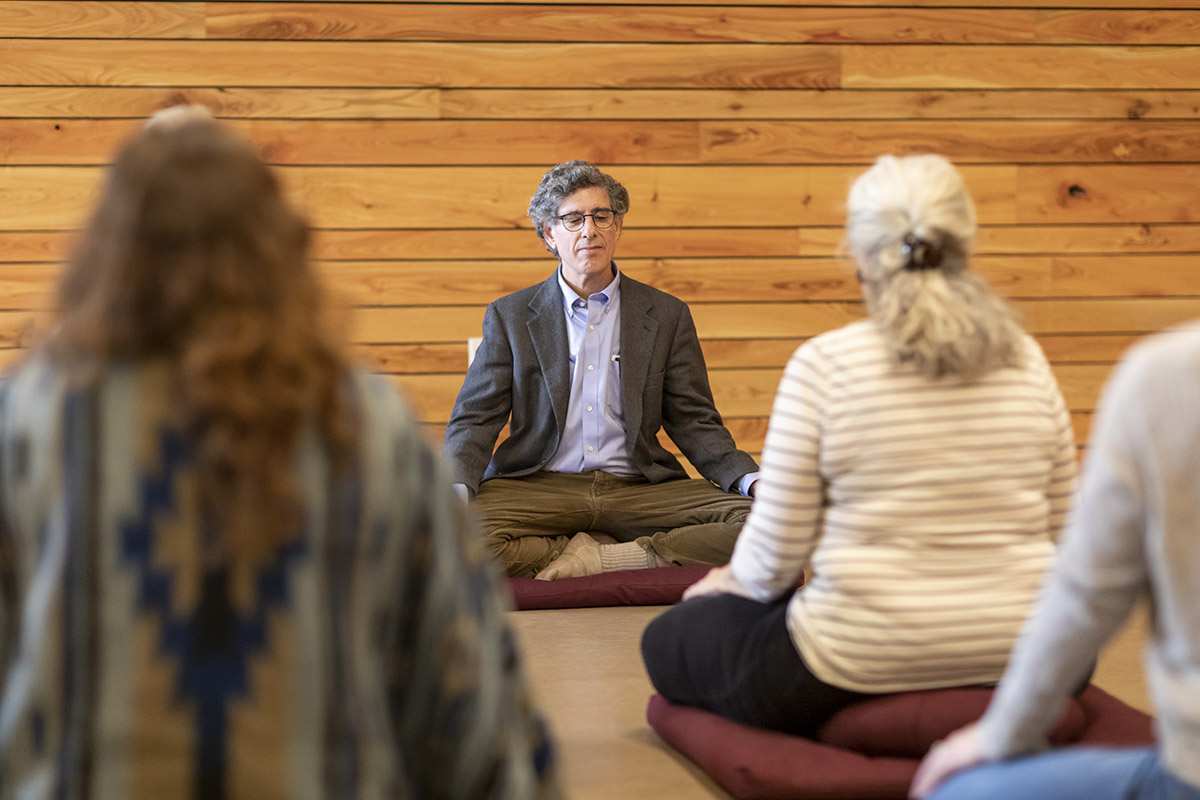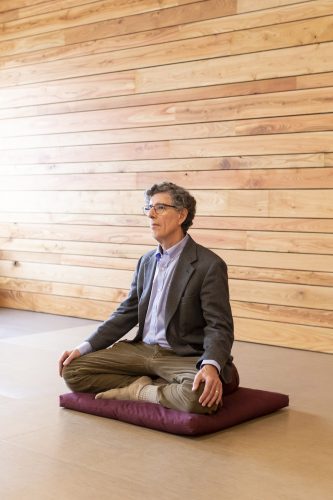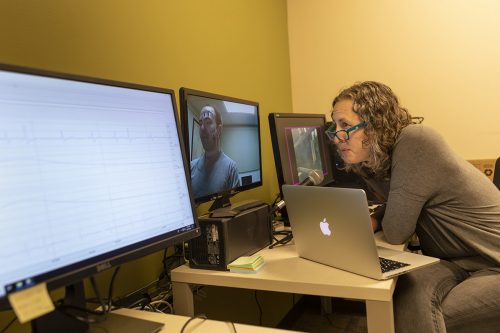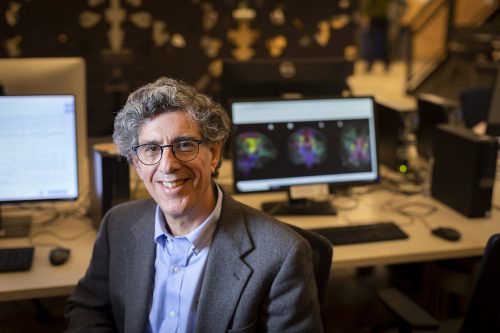
How Mindfulness Meditation Will Change Your Brain
Richard Davidson also found that contemplative practice enhances well-being.
With apps for every gadget and enough books to fill a bunker, meditation has become a trend in the stressed-out Western world. In the East, of course, it’s a way of life dating to ancient times.
In the 1970s, neuroscientist Richard “Richie” Davidson hiked through the Himalayas lugging heavy equipment to measure the brainwaves of meditators. At the time, the scientific community considered mindfulness unworthy of serious academic consideration. Undeterred, Davidson made the demanding journey to collect data from the world’s most experienced practitioners.
In the years since that foray, Davidson has become world-renowned in the science of linking the brain with contemplative practice. He counts the Dalai Lama among his friends.
Davidson and Daniel Goleman’s 2017 book, Altered Traits: Science Reveals How Meditation Changes Your Mind, Brain, and Body (Avery), teases the hype from the facts about the benefits of meditation.
As the William James and Vilas professor of psychology and psychiatry at the University of Wisconsin-Madison, Davidson is blazing trails regarding meditation and how it can enhance well-being by forming new and improved neural pathways. If humans adopted mindfulness on a wide scale, he said, we could chart a superior shared existence.
Your keynote speech at TCU’s Ronald E. Moore Humanities Symposium is on the nature of well-being. What will you discuss?
The title of my talk, at least in part, is “Well-Being Is a Skill.” The research that we have conducted has led us inevitably to this conclusion. The brain mechanisms that serve different components of well-being all exhibit plasticity, so they can be shaped by experience, and they also can be modified through training. So this has led us to the conclusion that it’s best to regard well-being as a skill.
“We actually spend very little time reflecting on our mind and coming to know our mind. And yet this is one of the most important features of what it means to be mindful.”
Richard Davidson
We can learn to cultivate, for example, resilience, which we define as the rapidity with which people recover from adversity. Some people recover quickly; some people recover more slowly. And it turns out that these variations among people are not immutable. They can be trained, and we can become more resilient. This is one of many examples that illustrate how we’ve been led to this conclusion that well-being is a skill. There are very simple kinds of mental exercises that are derived from the contemplative or meditative traditions that our research has demonstrated could be very helpful in fostering the core components of well-being.
If people, with a little practice, can become more adjusted to the frenetic, often stressful demands of the 21st century, why don’t more people develop these skills?
It’s not easy to spend time with one’s own mind. It actually is quite foreign to most people. Most people think that they know their mind, so to speak, because it’s almost an oxymoron to think that you might not. And yet, when we reflect on this most of the day, most every day, our attention is pulled by various external forces in the environment. We actually spend very little time reflecting on our mind and coming to know our mind. And yet this is one of the most important features of what it means to be mindful.
What have been your breakthrough moments while studying meditation in the laboratory?
One of our biggest “Aha!” moments was in studying the brains of very long-term meditation practitioners, people who have dedicated the vast majority of their life to cultivating these qualities of well-being. Although we certainly expected to see differences in their brains, the magnitude of these differences and the dramatic kinds of findings were surprising. Normally in human brain research, we take a lot of time to extract these very small signals from brain activity, and these signals are not visible with the naked eye. When we tested these very long-term practitioners, we actually saw signals with the naked eye in a way that we’ve never seen before. This was something quite unusual and dramatic.
“When we tested these very long-term practitioners, we actually saw signals with the naked eye in a way that we’ve never seen before. This was something quite unusual and dramatic.”
Richard Davidson
What signals are you seeing, and how are you seeing them in a technological sense?
In one of our first studies, we were recording brain electrical activity by putting electrodes on the practitioner’s head. And what we observed were very high-amplitude gamma oscillations — very fast-frequency oscillations. When they’re seen in the typical brains of most people, they’re seen for very, very short periods of time — less than one second, and typically at a very low amplitude; it’s not possible to actually see them with the naked eye.
And yet, in these long-term practitioners, we saw very high-amplitude gamma oscillations that were present for many, many minutes over time. And we also saw that these gamma oscillations were present in their baseline states in a way which was quite remarkable. These were some of the early observations that convinced us that these individuals’ brains were quite different from the brains of most other people we had studied.
In Altered Traits, you and Goleman present evidence that even less-experienced meditators can rewire their brains and become fundamentally different people in some ways. How can a meditation practice change people in a lasting way?
What Altered Traits really is referring to is the possibility of producing enduring change. When we sit on the meditation cushion, we’re not primarily doing this for the experience we might have when we’re meditating. If that were all meditation is, it would be like a drug. And when the drug begins to wear off, the effects go away. Really, we practice meditation because of the possibility of these practices influencing every nook and cranny of our everyday lives.

Richard Davidson, founder and director of the Center for Healthy Minds at the University of Wisconsin-Madison, leads a guided meditation group at the Center. Photo by Andy Manis
And so, in this book, we explore the scientific evidence on meditation to discern when changes begin to appear outside the meditation state in ways that permeate everyday life. And those do occur in people who are relatively novice practitioners, although it does take some amount of training before the effects really begin to endure.
For people who are interested in making positive changes in their daily lives, what are some recommended first steps?
One of the things we often say is that every little bit helps. In order to begin a practice like this, it’s important to do it in a way that is realistic, that is more geared to ensuring success rather than failure. We’re all very familiar with the reality of New Year’s resolutions that people make — to change their life, to eliminate bad habits and cultivate good habits — that never stick. And so one of our most important recommendations is that when people begin, they begin very, very modestly. What we often ask people to do is to reflect on the reality of their everyday life and come up with an amount of time that they believe they can dedicate to this kind of practice every single day for 30 consecutive days. Even if it is as short as one or two minutes, that’s OK.
One of the things I often say is that when human beings first evolved on this planet, none of us were brushing our teeth. And yet today, virtually every person on the planet brushes their teeth. We recognize that this is something that’s good for our personal hygiene. And my conjecture, based on everything I know as a scientist and as a meditation practitioner, is that if we spent even as short a time as we do brushing our teeth each day on nourishing our minds, this world would be a different place. It doesn’t take much, but we need to do it regularly and then gradually build up a habit.
You wrote that people can become more compassionate through an intentional mindfulness practice. If enough people developed their compassionate sides, how might society be different?
Compassion is the propensity to relieve the suffering of another, and one of the most important components of compassion is expanding our in-group. One of the most pernicious problems in the world today is the division between in-groups and out-groups. This is the basis of conflict all over the world, in our own country, across nations, between different groups, between different religious groups, between different political groups.
Anything that we can do to help expand our in-group is something that can be extremely valuable. And so the practices that are important for the cultivation of compassion include the gradual expansion of our in-group and being able to see that the wish to be happy and to be free of suffering is something quite universal. Every human being shares that. We can begin to extend our wish that others be happy and be free of suffering. We start with our in-group, but then we can gradually expand beyond our in-group in a way that can have a discernible impact on our behavior in everyday life. And research shows, for example, that on hard-nosed measures, objective measures of implicit bias, those measures begin to change as people engage in these very simple compassion practices that are very accessible.
What about transcending depression and anxiety, which can be isolating emotions? Is a mindfulness practice an effective way to combat these undesired states? Or do you think sufferers need a combination of medication, therapy and mindfulness?
There isn’t any single solution or single formula that will work for everyone. I often say that one size does not fit all. And we need to be sensitive to that. I think that these practices can be very helpful. I also think that, depending on the severity of the case, there are individuals who need something more than meditation. And that’s OK, and we need to recognize that.
In Altered Traits, you wrote that researchers in the field need to distinguish between different types of meditation. What are the general benefits of each type?
Mindfulness meditation is about cultivating awareness. Awareness is a quality that all human beings are endowed with. And one of the important features within the general domain of awareness is what in science is called meta-awareness, which is knowing that we’re aware or knowing what our mind is doing. It’s kind of the monitoring function of the mind. There are times when we don’t know what our mind is doing.
“Mindfulness meditation is about cultivating awareness. Awareness is a quality that all human beings are endowed with.”
Richard Davidson
For example, many of us have had the experience of driving sort of on automatic and going to a place or making a turn we really didn’t want to make because we don’t really know what our mind is doing. Many of us have had the experience of reading a book, when we actually are reading words on a page, and we may read a page, may read two pages, and after a few minutes, we realize that we have no idea what we just read because our mind is somewhere else. Those are all examples of us not knowing what our mind is doing at those times. Meta-awareness, which is our knowing what our mind is doing, can be strengthened by very simple forms of mindfulness meditation.

Robin Goldman, Center for Healthy Minds research support core director, simulates a research protocol with Ted Imhoff-Smith, a research specialist, at the center in Madison, Wisconsin. Using electromyography (EMG), electrocardiogram (EKG) and respiration, researchers can track facial muscles, heart rate, and breathing in response to a stimulus. This helps them understand emotional responses, how they relate to health and well-being, and how they differ across individuals. Photo by Andy Manis
The second kind of meditation is compassion or loving-kindness meditation, where we are intentionally cultivating certain emotional qualities. This is a very different kind of practice, where we may visualize a person who is a loved one, for example, or a stranger or a person that we have difficulty with. When we envision them, we recognize that they’re — just like us — sharing the same wish to be happy and to be free of suffering. And we cultivate a genuine aspiration that they be happy and free of suffering. This kind of practice leads to very different effects on the brain and the body, which can be very, very beneficial.
There’s another kind of meditation, which has hardly been studied in the West and yet is practiced extensively in the contemplative traditions in the East. It’s the kind of practice the Dalai Lama mostly does. And it’s called analytic meditation, where we use our thinking to reason about the nature of our mind. We ask ourselves questions like, “What is the mind? Where is the mind? What color is the mind? What shape is the mind? How extensive is the mind?” And we do the same thing with the self: “Where is the self? What is the self? Where does my self end and another self begin?” By asking ourselves these questions, we gain insight into the nature of our mind — and how our mind constructs reality — in a way that can be very, very helpful in freeing us from the kind of shackles that our minds can produce and that can constrain us in various ways.
So those are three different forms of meditation. There are many others.
Technology has advanced the way that you’re able to study the effects of a mindfulness practice on the brain. How do you see technology enhancing the way people practice meditation beyond today’s widespread apps?
I think that technology can play a very constructive role. I also hasten to add that, as most people would acknowledge, technology can also play a very destructive role, so it’s a double-edged sword. But I think that we can harness the power of technology — to remind us to practice, to provide us with guided practices, and in certain cases to remind us to practice in the moment.

Richard Davidson is the keynote speaker of the Ronald E. Moore Humanities Symposium, March 25, 2020, at TCU. Photo by Andy Manis
I’ll give you one example. One of the things that we are involved in studying collaboratively is addiction. And one of the key components of addiction is urges: A person has an urge to use a substance, use a drug, for example, when they’re experiencing certain kinds of distress or when they’re in certain kinds of environments. And people who are addicts tend to use drugs in specific locations. We can use GPS on a smartphone to monitor where a person is. And if they are approaching an area where they’ve used the drug before, we can alert them that they’re coming into difficult territory, geographically speaking. And this is a time for them to especially do a micropractice, to become mindful of the urges that might be catalyzed or unleashed by the environment that they’re in so they can overcome those urges, not succumb to them.
You are a prolific writer in addition to being an experienced meditator. What can you say about your personal connection between the practices of meditation and communication?
I think that they’re importantly related. Meditation can help you calm your mind and open your heart. And I believe that to be an effective communicator, it helps to have a clear mind and a warm heart.
Editor’s Note: The questions and answers have been edited for length and clarity.

Your comments are welcome
1 Comment
Is it possible to measure spirituality using EEG?
Related reading:
Alumni, Features
Duane Bidwell and the Complexity of an Interreligious World
Through his teaching and writing, the professor at Claremont School of Theology affirms the fluidity of religion.
Alumni
Mateo Marquez Teaches Mindfulness and Respect Through Yoga
The alumnus’ latest project, PoserKids Yoga, came after failure and acceptance.
Research + Discovery
Practice Mindfulness for Less Stress and Better Sleep
Students and faculty go with the flow of meditation and mindfulness.